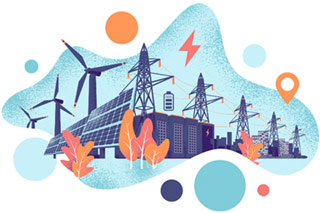To achieve climate neutrality by 2045, a comprehensive transformation of the energy system in Germany is necessary. The Institute of Energy Economics at the University of Cologne (EWI) - affiliate institute of the Faculty of Management, Economics and Social Sciences - has now examined what this could look like on behalf of the German Energy Agency (dena) as part of the “dena-Leitstudie Aufbruch Klimaneutralität”. In a scenario, the expert report “Climate Neutrality 2045 – Transformation of the Consumption Sectors and the Energy System” describes a consistent path for achieving the German climate goals. The scenario is based on the Climate Protection Act 2021 and, in addition to the sectoral climate targets in 2030, also takes into account the cross-sectoral reduction targets in the following years.
In the scenario, final energy consumption falls by around 41 percent by 2045 compared to 2018 - due to innovative technologies, energy efficiency and changes in mobility behaviour. Natural gas, oil and coal are replaced by electricity and hydrogen. "From 2030 onwards, electricity will become the most important final energy source. In the scenario, gross electricity demand increases to 698 TWh by 2030 and to 910 TWh by 2045," says EWI manager Dr Johannes Wagner. By 2030, electricity generation from renewable energies will roughly double and reach a share of 68 percent of gross electricity demand. The coal phase-out will be accelerated in a market-driven way. In addition to electricity, hydrogen and hydrogen derivatives such as synthetic paraffin will play a central role in the long term.
For the three end-use sectors of industry, transport and buildings, the expert report develops transformation paths for sectoral energy consumption based on bottom-up models. Each sector contributes to the reduction of energy consumption. In the transport sector, for example, energy consumption is decreasing as domestic flights and car traffic are partly shifted to more environmentally friendly buses and trains. In addition, the share of electric vehicles is increasing significantly. "In the scenario, there are about 14 million electric cars on the road in Germany by 2030 and about 35 million in 2045," says EWI manager Max Gierkink.
In the industrial sector, innovative process technologies, such as those used in the steel industry, could greatly reduce emissions. Likewise, efficiency improvements reduce energy consumption across all sectors. The greater use of electricity-based technologies would reduce the use of fossil fuels.
In the building sector, according to the scenario, "about 4.1 million electric heat pumps will be used in residential buildings in 2030 and about 9 million in 2045". Concerning the energy refurbishment rate, the EWI scientists estimate a doubling to 1.9 percent annually. Hydrogen will be used in the building sector from 2030 onwards, initially as part of a blending process in the distribution grids.
Electricity generation will become almost climate-neutral as early as 2040, according to the report. Electricity generation from renewable energies will almost double by 2030 and reach a share of 68 percent of gross electricity demand. Due to the decline in conventional electricity generation, Germany will change from a net electricity exporter to a net electricity importer from 2030 onwards.
In the scenario, a rapidly growing hydrogen economy is already developing in the 2020s. In 2045, a total of 458 TWh of green hydrogen will be in demand. Both domestic production and imports increase significantly. In addition to hydrogen, however, Germany will also be dependent on liquid (oil-based) energy sources in the long term.
According to the scenario, climate neutrality will be achieved in 2045. There would still be about 87 million tonnes of CO2 equivalents, for example from agriculture and remaining process emissions in industry and the building sector. However, these emissions would be offset, for example, by technical CO2 avoidance options such as carbon capture and use/storage (CCU/S). In combination with the use of biomass in the energy sector, a technical sink would be created. In addition, natural sinks such as forests and peatlands would achieve a capacity of 41 million tonnes of CO2. These natural sinks could also be counted towards the goal of net carbon neutrality in 2045.
